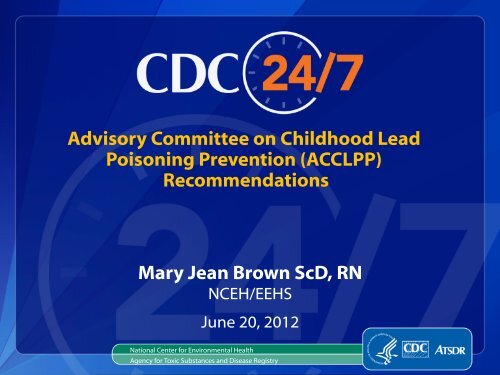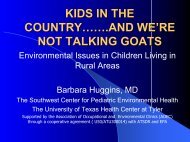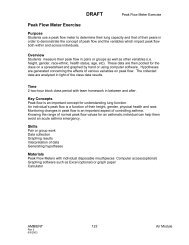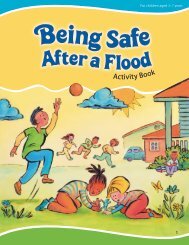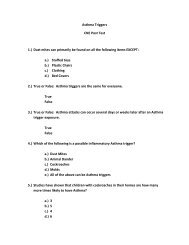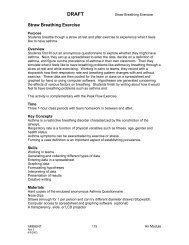(ACCLPP) Recommendations - Southwest Center for Pediatric ...
(ACCLPP) Recommendations - Southwest Center for Pediatric ...
(ACCLPP) Recommendations - Southwest Center for Pediatric ...
Create successful ePaper yourself
Turn your PDF publications into a flip-book with our unique Google optimized e-Paper software.
Advisory Committee on Childhood Lead<br />
Poisoning Prevention (<strong>ACCLPP</strong>)<br />
<strong>Recommendations</strong><br />
Mary Jean Brown ScD, RN<br />
NCEH/EEHS<br />
June 20, 2012<br />
National <strong>Center</strong> <strong>for</strong> Environmental Health<br />
Agency <strong>for</strong> Toxic Substances and Disease Registry
Background<br />
q November 10, 2010: <strong>ACCLPP</strong> established ad hoc<br />
Blood Lead Level workgroup<br />
§ Determine whether the CDC ‘blood lead level of concern’ of<br />
10 μg/dL in children continues to be protective<br />
§ Consider laboratory capability <strong>for</strong> measuring BLLs in<br />
evaluating guidance<br />
§ Advise CDC on how to communicate advisories to groups<br />
affected by policy changes concerning:<br />
• Interpretation of childhood BLLs and trends in childhood BLLs<br />
over time<br />
• Screening and follow-up screening intervals<br />
• Requirements and procedures <strong>for</strong> notifying parents or<br />
guardians concerning BLL test results<br />
• Interventions known to control or eliminate lead exposure<br />
3
Blood Lead Level Workgroup Report<br />
q November 16–17, 2011: <strong>ACCLPP</strong> met and<br />
deliberated on draft report<br />
q January 4, 2012: <strong>ACCLPP</strong> met and majority<br />
approved report, including recommendations<br />
4
Recommendation 1<br />
Based on the scientific evidence, the <strong>ACCLPP</strong> recommends that (a)<br />
the term, “level of concern”, be eliminated from all future agency<br />
policies, guidance documents, and other CDC publications, and (b)<br />
current recommendations based on the “level of concern” be<br />
updated according to the recommendations contained in this report.<br />
q<br />
Concur<br />
§ Emphasize best way to end childhood lead poisoning is<br />
to prevent, control, or eliminate lead exposures<br />
§ Discontinue using term ‘level of concern’ in future<br />
publications<br />
§ Replace term with reference value and date of NHANES<br />
used to calculate reference value<br />
5
Recommendation 2<br />
CDC should use a childhood BLL reference value based on the 97.5th<br />
percentile of the population BLL in children aged 1–5 years (currently<br />
5 µg/dL) to identify children living or staying <strong>for</strong> long periods in<br />
environments that expose them to lead hazards. Additionally, the reference<br />
value should be updated by CDC every 4 years based on the most recent<br />
population-based–blood-lead surveys conducted among children.<br />
q<br />
Concur in principle<br />
§ Use reference value in recommendations<br />
§ Use reference value to identify high-risk childhood<br />
populations and geographic areas most in need of<br />
primary prevention<br />
§ Provide in<strong>for</strong>mation, including specic high-risk areas,<br />
to federal, state, and local government agencies and<br />
nongovernment organizations<br />
6
Recommendation 3<br />
CDC should develop and help implement a nationwide primaryprevention<br />
policy to ensure that no children in the United States<br />
live or spend significant time in homes, buildings, or other<br />
environments that expose them to lead hazards.<br />
q<br />
Concur in principle<br />
§ Recognizes value of primary prevention<br />
§ As feasible, develop strategies and guidelines<br />
<strong>for</strong> primary prevention<br />
§ Resources to support primary-prevention<br />
programs not currently practicable<br />
7
Recommendation 4<br />
Clinicians should be a reliable source of in<strong>for</strong>mation on lead hazards<br />
and take the primary role in educating families about preventing lead<br />
exposures. This includes recommending environmental assessments<br />
PRIOR to blood lead screening of children at risk <strong>for</strong> lead exposure.<br />
q<br />
Concur in principle<br />
§ CDC will play a supportive role by working<br />
with providers to provide educational<br />
material<br />
8
Recommendation 5<br />
Clinicians should monitor the health status of all children with a<br />
confirmed BLL ≥ 5 µg/dL <strong>for</strong> subsequent changes in BLL until all<br />
recommended environmental investigations and mitigation strategies<br />
have been completed. Clinicians also should provide BLL test results to<br />
the families of all affected children in a timely and appropriate manner.<br />
q<br />
Concur in principle<br />
§ CDC will play supportive role by working with<br />
providers to provide educational material<br />
9
Recommendation 6<br />
Clinicians should ensure that BLL values at or higher than the reference<br />
value are reported to local and state health or housing departments if<br />
no mandatory laboratory reporting exists. Clinicians also should<br />
collaborate with these agencies to ensure that the appropriate services<br />
and resources provided to children and their families.<br />
q<br />
Concur in principle<br />
§ CDC will play supportive role through continued work<br />
with<br />
• testing laboratories<br />
• point-of-care instrument manufacturers<br />
• clinical health care providers<br />
10
Recommendation 7<br />
Educate families, service providers, advocates, and public<br />
officials on the primary prevention of lead exposure in<br />
homes and other child-occupied facilities to ensure that<br />
lead hazards are eliminated be<strong>for</strong>e children are exposed.<br />
q<br />
Concur in principle<br />
§ Provide available educational materials through CDC Web site<br />
§ Seek assistance of partners to implement recommendation<br />
§ Resources not available <strong>for</strong> supporting local capacity<br />
11
Recommendation 8<br />
CDC should encourage local, state, and other federal agencies to: (a) facilitate<br />
data-sharing between health and housing agencies, (b) develop and en<strong>for</strong>ce<br />
preventive lead-safe housing standards <strong>for</strong> rental and owner-occupied housing,<br />
(c) identify financing <strong>for</strong> lead hazard remediation, and (d) provide families with<br />
the in<strong>for</strong>mation they need to protect their children from hazards in the home.<br />
q<br />
q<br />
Concur in principle<br />
§ Continue to recommend health and housing agencies share data<br />
used to identify geographic areas where lead-exposure risk is high<br />
§ Encourage local, state, and federal agencies to en<strong>for</strong>ce standards<br />
found in CDC’s guidelines <strong>for</strong> lead-safe housing<br />
§ HUD Lead Hazard Control Program most easily identiable and<br />
largest source of federal funding <strong>for</strong> lead-hazard remediation<br />
§ Resources not available <strong>for</strong> supporting local capacity<br />
Concur<br />
§ Continue to distribute existing materials<br />
§ Consider future development of new materials<br />
12
Recommendation 9<br />
Elected officials and the leaders of health, housing, and<br />
code en<strong>for</strong>cement agencies can help protect the children<br />
in their jurisdictions from lead exposure in their homes<br />
through many activities. CDC should work with officials to<br />
ensure adoption of a suite of preventive policies.<br />
q<br />
Concur in principle<br />
§ Consider educating state and local elected ofcials<br />
about importance of primary prevention and<br />
evidenced-based strategies at national level<br />
§ Resources not available <strong>for</strong> supporting local capacity<br />
13
Recommendation 10<br />
CDC should (a) emphasize the importance of environmental<br />
assessments to identify and mitigate lead hazards be<strong>for</strong>e children<br />
demonstrate BLLs at or higher than the reference value and (b)<br />
adopt prevention strategies to reduce environmental lead exposures<br />
in soil, dust, paint, and water be<strong>for</strong>e children are exposed.<br />
q<br />
q<br />
Concur<br />
§ Continue to work with other agencies on lead<br />
poisoning prevention activities<br />
Concur in principle<br />
§ Work with federal agencies including, but not<br />
limited to, HUD and EPA<br />
§ Goal will be to develop primary prevention<br />
strategies<br />
14
Recommendation 11<br />
If a lead hazard that requires a response is found in any unit in<br />
a multifamily housing complex, the same response must be<br />
applied to all similar untested units in the complex unless a risk<br />
assessment demonstrates that no lead hazards are<br />
present in the other units.<br />
q<br />
Concur in principle<br />
§ Will explore implementing recommendations<br />
<strong>for</strong> increased inspections<br />
15
Recommendation 12<br />
CDC should encourage additional research directed<br />
towards developing interventions capable of maintaining<br />
children’s BLLs lower than the reference value.<br />
q<br />
Concur in principle<br />
§ Work with National Institute of Environmental Health Sciences<br />
(NIEHS) and academic partners to encourage research<br />
• Research designed to develop and evaluate effective, broadly<br />
useful interventions that are effective in complex lead-exposure<br />
situations commonly encountered<br />
§ Will explore strategies to support additional research<br />
16
Recommendation 13<br />
Additional research priorities should include improving the use of data from<br />
screening programs, developing next generation point-of-care lead analyzers,<br />
and improving the understanding of epigenetic mechanisms of lead action.<br />
q<br />
Concur<br />
§ Work with NIEHS, academic partners, and laboratory<br />
instrument manufacturers to encourage research in these<br />
important areas<br />
17
National <strong>Center</strong> <strong>for</strong> Environmental Health<br />
Agency <strong>for</strong> Toxic Substances and Disease Registry


